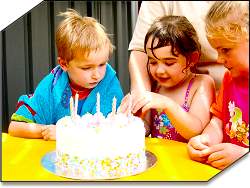 Through the divorce process, children deal with many changes. One of the most significant adjustments children have to make is living in two homes. Even if a child visits one parent for a few hours a week, the child should feel at home there. This helps foster connection with the non-custodial parent and helps the child to recognize that the non-custodial parent didn’t “divorce” him/her. Issues of abandonment and rejection are paramount for children of all ages, although the young ones can’t express it and the older ones either won’t or they “act out.” Creating a sense of belonging in both homes assists the child in making a healthy transition. Many children actually enjoy having two homes because they get special attention; often have two birthday parties and two sets of Christmas or Chanukah gifts.
Through the divorce process, children deal with many changes. One of the most significant adjustments children have to make is living in two homes. Even if a child visits one parent for a few hours a week, the child should feel at home there. This helps foster connection with the non-custodial parent and helps the child to recognize that the non-custodial parent didn’t “divorce” him/her. Issues of abandonment and rejection are paramount for children of all ages, although the young ones can’t express it and the older ones either won’t or they “act out.” Creating a sense of belonging in both homes assists the child in making a healthy transition. Many children actually enjoy having two homes because they get special attention; often have two birthday parties and two sets of Christmas or Chanukah gifts.
Here are some tips to help children adjust:
- The child should have her own room. If this isn’t possible, she should have her own space in a room – her own dresser drawer, a toy bin, some shelves.
- He should be allowed to keep his things in that space and arrange them as he wants to.
- Let the child help decorate the space. By picking out her own sheets or a poster to hang on the wall, she personalizes the space.
- He should have clothes in both spaces.
- She should be allowed to carry her things back and forth between two houses. This helps with the transition.
- Parents should cooperate in returning clothes and toys.
- Pick up and drop off should always be cordial, on time and upbeat. Save your hostility for court.
- Children should go with the non-custodial parent even when sick. This reinforces both parents’ ability to care for the child. It helps the child feel he is safe with both parents and part of a household. When we only send children when they are healthy, the message is that one parent is really the “reliable one.” It undermines the other parent and creates a “Disneyland Dad.”
- Rules and consequences should exist in both homes. Many non-custodial parents are afraid they will “ruin” visitation if they discipline the child. Parenting involves both discipline and respect. If you don’t want to feel like an outsider, don’t act like one.
- If possible, rules in both homes should be similar. If they differ, it is not the end of the world as long as each parent is consistent in their own home. Children learn at a very early age that there are different rules in different places – school, camp, church, grandma’s house. They can handle another difference as long as the rules are reliable and consistent in each environment.
- The child should be allowed to call the other parent, but should not be made to do so.
Consider showing this page to your child’s other parent as a way to open dialogue on how to make this transition as easy and stress free for the child as possible. Put aside all your hurt and angry feelings about the marriage and deal with your former spouse as your child’s parent, knowing that when your child has a good relationship with both of you, he/she will thrive.
 ©2009. Donna F. Ferber, LPC, LADC is a licensed psychotherapist in Connecticut. Her newest book, is available at bookstores everywhere, Amazon.com or at her website. This article is from her first book, From Ex-Wife to Exceptional Life: A Woman’s Journey through Divorce which won an Honorable Mention Award by the Independent Publishers Association. To read more about the author and her work, please visit www.donnaferber.com
©2009. Donna F. Ferber, LPC, LADC is a licensed psychotherapist in Connecticut. Her newest book, is available at bookstores everywhere, Amazon.com or at her website. This article is from her first book, From Ex-Wife to Exceptional Life: A Woman’s Journey through Divorce which won an Honorable Mention Award by the Independent Publishers Association. To read more about the author and her work, please visit www.donnaferber.com
© 2010 – 2011, Ohio Family Law Blog. All rights reserved.

Donna F. Ferber, is a psychotherapist in private practice since 1986. She is a licensed professional counselor, a licensed alcohol and drug abuse counselor and an educator. Donna works with individuals and in groups. Her office is in Farmington, Connecticut.




